FORD SUPERDUTY F-SERIES
INTERIOR
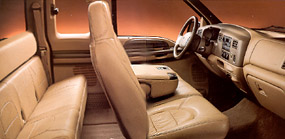 The SuperDuty F-Series
cab dimensions vary by model, but shoulder room is
increased by more than 3 inches and hip room by more than 5 inches. The truck's
instrument panel, with a grained finish, has extra room to integrate aftermarket equipment
controls. There are no exposed screws or fasteners, except the quarter-turn
fasteners on the panel beneath the steering column. This panel can be opened with a
coin or screwdriver for access to fuses and aftermarket electrical prep relays and
modules.
The SuperDuty F-Series
cab dimensions vary by model, but shoulder room is
increased by more than 3 inches and hip room by more than 5 inches. The truck's
instrument panel, with a grained finish, has extra room to integrate aftermarket equipment
controls. There are no exposed screws or fasteners, except the quarter-turn
fasteners on the panel beneath the steering column. This panel can be opened with a
coin or screwdriver for access to fuses and aftermarket electrical prep relays and
modules.
A cross-vehicle tubular beam behind the instrument
panel adds stiffness and helps reduce steering wheel vibration and a central, center-stack
console positions the radio at the top for easy accessibility and climate controls
below. Two large cup holders are beneath the climate controls. An ashtray is
positioned low and away from air vents to prevent ashes from blowing around the cab.
The instrument panel also features optional passenger
air bags with a passenger air bag deactivation switch on Regular Cabs and SuperCabs.
Large, easy-to-read gauges and a standard tachometer and warning lights are integrated in
the cluster. A standard low-fuel warning light, illuminates when only three gallons
remain in the tank. The radio has large 100 mm buttons and a large rotary volume
knob and an integrated electronic clock is included in the radio. The optional
dual-media sound system plays cassettes or CDs.
A cigar lighter and second power point outlet is
included. The second power point is designed for a higher current than the cigar
lighter. The glove box is also larger and the glove box latch is closer to the
driver for easy access.
Three-across passenger seating features a new fabric,
selected for durability and easy cleaning, with new sew patterns in new colors. The
base vehicle has a straight-across bench with integrated head restraints available in all
vinyl, Denver Knit breathable vinyl or cloth. All seats, including the base bench
seat, are pressure-mapped to ease fatigue and increase long-distance driving comfort.
Pressure mapping uses computer studies to design seats that spread the occupant contact
pressure across the seat surface.
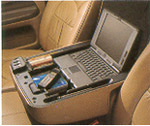 Upgraded seats are a 40-20-40 split-bench. The center provides
room for a fold-down armrest and a utility bin that can house a portable fax machine or
laptop computer and disc or cassette storage. Seats are larger than in the current
truck and offer a more natural body position and an increased seat-back angle to improve
seating posture. Seat track travel is increased 1.5 inches.
Upgraded seats are a 40-20-40 split-bench. The center provides
room for a fold-down armrest and a utility bin that can house a portable fax machine or
laptop computer and disc or cassette storage. Seats are larger than in the current
truck and offer a more natural body position and an increased seat-back angle to improve
seating posture. Seat track travel is increased 1.5 inches.
The SuperCab back seat is a full bench with a bolster
across the top. A lower cushion-to-seat back incline of 15 degrees from vertical
provides an increased angle for occupant comfort. The seat back and seat cushion
fold down and articulate to create a flat steel load floor. The Crew Cab XLT and
Lariat models have a new bench rear seat that incorporates a fold-down armrest tor rear
occupant comfort. A cup holder, designed to accommodate a cup with handle is mounted at
the lower cushion center position. Rear seats in the Crew Cab have the same
21-degree seat-back angle and chair height as the front seat. Child safety locks are
standard. Leather seating surfaces are included on the Lariat series.
STORAGE
Regular Cab offers a stacked three-unit system behind
the front seat that is standard on XLT and Lariat. A removable upper bin is there to
stow tools and other smaller items and a single second-level bin that can be placed on the
driver's or passenger's side of the truck. The bin is secured when the truck is
moving. A lower, compartmentalized bin with a jack mounting provision also permits
the second bin to fit over the top as a cover.
The Crew Cab storage system consists of the single
second-level bin used on the Regular Cab. It is fixed, adjacent to the jack and
accessible by pushing the rear seat-back forward. An overhead console, standard on
Lariat and unavailable on other series, includes a trip computer, compass, average fuel
economy, distance to empty readout and storage area for a garage door opener or other
small items.
An floor console with captain's chairs that contains a
flat writing surface is also available, which serves as a storage bin cover. It can
store a laptop computer and includes cassette and CD-sized case holders, and a coin
dispenser. A clip, mounted at the front of the writing area, will secure a pad of
paper or documents. An external utility tray serves many purposes.
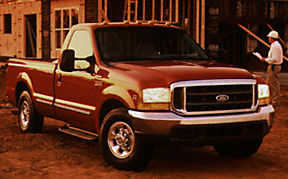
The SuperDuty F-Series rests on a chassis that was
lengthened 4 inches for Regular and Crew Cab models and 3 inches for SuperCab models to
accommodate larger cabs without compromising load room. SuperDuty F-Series trucks
retain the Built Ford Tough family resemblance. The front of the truck delivers a
strong identity with a new pronounced power dome hood signature Ford grille, massive
all-steel bumper and standard aerodynamic sealed-beam headlamps flush to the sheet
metal. From a design perspective the front end had to be the most impressive
part. It provides the truck's signature and that's where the power is.
Aggressive air inlets that flank the grille and the dropped beltline side window glass
were borrowed from the heavy duty market to signal SuperDuty F-Series' serious work
nature.
A View from the Side
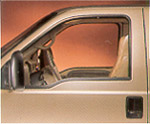 Longer doors with recessed narrow rocker extensions help improve
entrance into the truck. The longer doors also improve access to the storage space behind
the Regular Cab's front seat. Seals along the bottom of the doors help keep door openings
dirt-free and occupants clothing clean.
Longer doors with recessed narrow rocker extensions help improve
entrance into the truck. The longer doors also improve access to the storage space behind
the Regular Cab's front seat. Seals along the bottom of the doors help keep door openings
dirt-free and occupants clothing clean.
Teflon bushings in the door hinges virtually eliminate
the need for lubrication and help improve door fit. Soft cushions within the hinge
system reduce the likelihood of the doors bouncing back when swung open. All door
systems have horizontal beams and the SuperCab rear doors also have vertical beams to
increase the structural integrity of the door system. This will reduce the possibility of
wind noise water leaks and squeaks and rattles. The outer and inner sheet metal
panels have a corrosion-resistant galvanized coating on both sides.
SuperCabs have four standard doors, including rear
doors, that hinge on the rear pillar of the cab and swing out 90 degrees from the door
sill, allowing access to the rear compartment. The doors feature an interlock lever
that prevents them from being unlatched unless the front door is open. The SuperCab
was designed with no B-pillar for easy-access-loading of people and cargo.
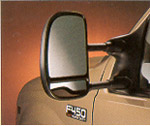 The dropped belt-line window provides additional visibility for
drivers sitting high in the cabin and is especially helpful to drivers towing
trailers. Flush glass and door edge seals help reduce wind noise. SuperDuty
F-Series uses the same locking tailgate as the current F- 150.
The dropped belt-line window provides additional visibility for
drivers sitting high in the cabin and is especially helpful to drivers towing
trailers. Flush glass and door edge seals help reduce wind noise. SuperDuty
F-Series uses the same locking tailgate as the current F- 150.
FIRST STANDARD FOUR-DOOR SUPERCAB ADDS
VERSATILITY TO SUPERDUTY F-SERIES PICKUPS
Ford Motor Company introduces the industry's first
SuperCab with standard four doors in the over-8,500-pound GVW truck segment with its
SuperDuty F-Series pickups. SuperCab models are available in the
F-250 and F-350. The SuperCab's rear seat is standard on XLT and Lariat models and
is an option with the XL trim level. Its cushion folds up and forward, and the
seatback folds down to create a steel flat-loading surface. Many commercial users
are expected to use the rear space for storage only. The 25-inch-wide rear doors
hinge on the rear pillars of the cab and swing out 90 degrees from the door side.
This is an excellent way to gain access to the rear, the doors open but there are no
B-pillars in the way to hinder the loading of items and people getting in and out.
Ford didn't want to extend the length of the cab by
adding another set of pillars. So a hidden hinge was used that provides a maximum door
opening. A front door must be open before the rear doors can be opened. The
rear doors have two handles -- one on the outside door face for entering the pickup and
another inside the door trim panel to allow rear-seat passengers easy exit once a front
door has been opened. Both rear doors are secured with double latches and with the
front and rear doors closed the rear door is locked automatically.
The rear doors also contribute to overall passenger
safety and are provided extra strength by vertical beams with a cross brace where the
front and rear doors meet. The vertical beam is an additional safety feature beyond
the horizontal side-door intrusion beam and is linked to the passenger-side front beam.
Not only does the vertical beam make the rear door very
rigid, it improves the overall structural integrity of the cab. This should sharply
reduce the possibility of wind noise, water leaks, and squeaks and rattles that might
normally occur when the two doors come together.
Last modified:
Thursday December 13, 2007 07:35 AM
 The SuperDuty F-Series
cab dimensions vary by model, but shoulder room is
increased by more than 3 inches and hip room by more than 5 inches. The truck's
instrument panel, with a grained finish, has extra room to integrate aftermarket equipment
controls. There are no exposed screws or fasteners, except the quarter-turn
fasteners on the panel beneath the steering column. This panel can be opened with a
coin or screwdriver for access to fuses and aftermarket electrical prep relays and
modules.
The SuperDuty F-Series
cab dimensions vary by model, but shoulder room is
increased by more than 3 inches and hip room by more than 5 inches. The truck's
instrument panel, with a grained finish, has extra room to integrate aftermarket equipment
controls. There are no exposed screws or fasteners, except the quarter-turn
fasteners on the panel beneath the steering column. This panel can be opened with a
coin or screwdriver for access to fuses and aftermarket electrical prep relays and
modules. Upgraded seats are a 40-20-40 split-bench. The center provides
room for a fold-down armrest and a utility bin that can house a portable fax machine or
laptop computer and disc or cassette storage. Seats are larger than in the current
truck and offer a more natural body position and an increased seat-back angle to improve
seating posture. Seat track travel is increased 1.5 inches.
Upgraded seats are a 40-20-40 split-bench. The center provides
room for a fold-down armrest and a utility bin that can house a portable fax machine or
laptop computer and disc or cassette storage. Seats are larger than in the current
truck and offer a more natural body position and an increased seat-back angle to improve
seating posture. Seat track travel is increased 1.5 inches.
 Longer doors with recessed narrow rocker extensions help improve
entrance into the truck. The longer doors also improve access to the storage space behind
the Regular Cab's front seat. Seals along the bottom of the doors help keep door openings
dirt-free and occupants clothing clean.
Longer doors with recessed narrow rocker extensions help improve
entrance into the truck. The longer doors also improve access to the storage space behind
the Regular Cab's front seat. Seals along the bottom of the doors help keep door openings
dirt-free and occupants clothing clean. The dropped belt-line window provides additional visibility for
drivers sitting high in the cabin and is especially helpful to drivers towing
trailers. Flush glass and door edge seals help reduce wind noise. SuperDuty
F-Series uses the same locking tailgate as the current F- 150.
The dropped belt-line window provides additional visibility for
drivers sitting high in the cabin and is especially helpful to drivers towing
trailers. Flush glass and door edge seals help reduce wind noise. SuperDuty
F-Series uses the same locking tailgate as the current F- 150.